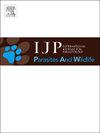Molecular detection of Leishmania and other vector-borne agents in free-ranging and captive herpetofauna from Costa Rica
IF 2.2
3区 医学
Q3 ECOLOGY
International Journal for Parasitology-Parasites and Wildlife
Pub Date : 2025-05-27
DOI:10.1016/j.ijppaw.2025.101090
引用次数: 0
Abstract
Vector-borne pathogens in amphibians and reptiles represent an emerging concern in wildlife, with implications for ecosystem dynamics and potential zoonotic risks. In this study, we screened 108 animals from Costa Rica, including 46 captive snakes, 24 free-ranging reptiles, and 38 free-ranging amphibians, for the presence of Trypanosomatidae, Anaplasmataceae, Borrelia, Rickettsia, and Hepatozoon spp. Blood smear analysis revealed protozoa gametocytes in 3.7 % of the animals sampled, and 11.1 % of amphibians and reptiles were molecular positive for at least one pathogen. Specifically, 7.4 % of the samples tested positive for Leishmania spp., 1.85 % for Trypanosoma spp., 0.9 % for Anaplasma spp., and 1.85 % for Hepatozoon spp. Notably, this study reports the first molecular detection of Leishmania in an amphibian species (Rhinella horribilis) and confirms the presence of mammalian pathogenic Leishmania infantum in captive snakes in Central America. The presence of potential zoonotic agents in both captive and free-ranging herpetofauna underscores the importance of screening wildlife species, including understudied host groups such as amphibians, to better understand their role in disease ecology.

哥斯达黎加自由放养和圈养疱疹动物中利什曼原虫和其他媒介传播媒介的分子检测
两栖动物和爬行动物中媒介传播的病原体是野生动物中一个新出现的问题,对生态系统动力学和潜在的人畜共患风险具有影响。在这项研究中,我们筛选了来自哥斯达黎加的108只动物,包括46只圈养蛇,24只自由放养的爬行动物和38只自由放养的两栖动物,检测了锥虫科、无形体科、伯氏疏螺旋体、立克次体和肝虫等动物。血液涂片分析显示,3.7%的动物样本中有原生动物配子体,11.1%的两栖动物和爬行动物至少有一种病原体分子阳性。具体来说,7.4%的样本检测利什曼原虫阳性,1.85%的样本检测锥虫阳性,0.9%的样本检测无形体阳性,1.85%的样本检测肝虫阳性。值得注意的是,本研究报告了首次在两栖动物物种(可怕的鼻虫)中检测到利什曼原虫的分子,并证实了中美洲圈养蛇中存在哺乳动物致病性幼利什曼原虫。圈养和自由放养的爬行动物中都存在潜在的人畜共患病原体,这强调了筛选野生动物物种的重要性,包括两栖动物等尚未得到充分研究的寄主群体,以便更好地了解它们在疾病生态学中的作用。
本文章由计算机程序翻译,如有差异,请以英文原文为准。
求助全文
约1分钟内获得全文
求助全文
来源期刊

International Journal for Parasitology-Parasites and Wildlife
Medicine-Infectious Diseases
CiteScore
3.80
自引率
5.60%
发文量
113
审稿时长
45 days
期刊介绍:
The International Journal for Parasitology: Parasites and Wildlife (IJP-PAW) publishes the results of original research on parasites of all wildlife, invertebrate and vertebrate. This includes free-ranging, wild populations, as well as captive wildlife, semi-domesticated species (e.g. reindeer) and farmed populations of recently domesticated or wild-captured species (e.g. cultured fishes). Articles on all aspects of wildlife parasitology are welcomed including taxonomy, biodiversity and distribution, ecology and epidemiology, population biology and host-parasite relationships. The impact of parasites on the health and conservation of wildlife is seen as an important area covered by the journal especially the potential role of environmental factors, for example climate. Also important to the journal is ''one health'' and the nature of interactions between wildlife, people and domestic animals, including disease emergence and zoonoses.
 求助内容:
求助内容: 应助结果提醒方式:
应助结果提醒方式:


